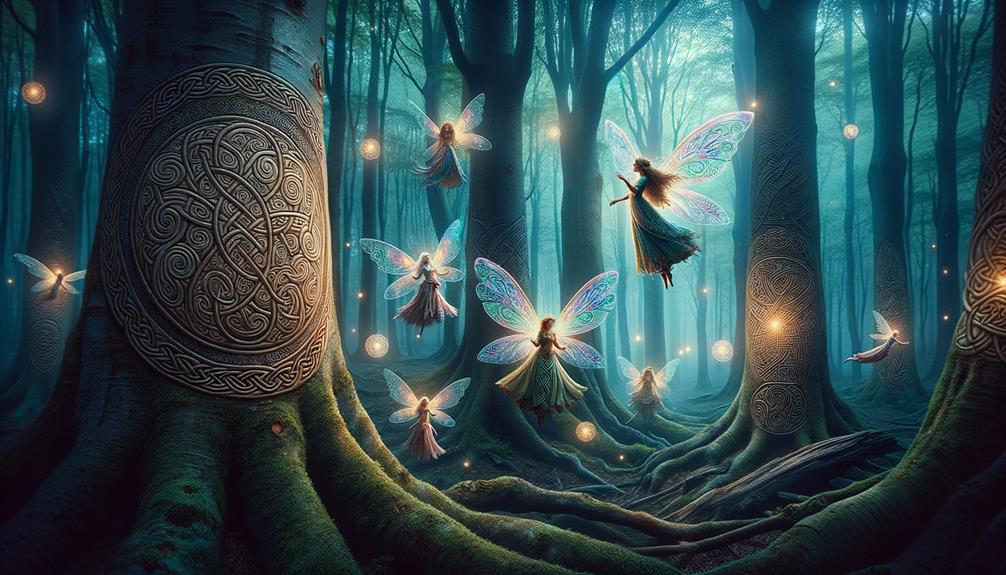Discovering the Mystical World of Celtic Fairies
Celtic fairy myths and legends: more than just imaginative stories. In my experience, they're a captivating fusion of cultural insights, historical background, and intricate metaphysical ideas. These tales, rich with nature, magic, and the otherworldly, provide a window into Celtic views on life, death, and the universe.
Meet the Celtic Fairies: From playful leprechauns to eerie banshees, each fairy character unveils a unique facet of ancient Celtic philosophies and principles. By delving into these stories, we can uncover profound truths about human existence and our innate quest to comprehend our world.
Embark on a Mystic Journey: Join me as we navigate the labyrinth of these ageless narratives, unearthing the hidden treasures within.
Celtic Fairy Lore: A Treasure Trove of Wisdom
To truly appreciate these narratives, we must approach them with a spirit of curiosity and openness. Instead of dismissing them as mere fabrications, let's view them as portals into a bygone era. To the Celts, fairies were not merely whimsical creatures – they were integral to their understanding of life and the cosmos.
Take, for example, the mischievous leprechaun. Far from being a mere trickster, this fairy embodies the Celtic value of cleverness and the importance of not taking life too seriously. On the other hand, the wailing banshee serves as a poignant reminder of the inevitability of death and the transient nature of life.
Unraveling Celtic Fairy Legends: A Path to Understanding Humanity
Understanding these tales is more than an academic exercise – it's a journey into the heart of what it means to be human. By exploring the profound metaphysical concepts these stories present, we can gain insights into our own existence.
So, let's take this journey together. Let's decode the mysteries of Celtic fairy lore, and in doing so, perhaps we'll learn a bit more about ourselves.
In conclusion, Celtic fairy myths and legends are not just fanciful tales – they are a profound exploration of life, death, and the cosmos from a uniquely Celtic perspective. By engaging with these stories, we can enrich our own understanding of the world and our place within it.
Understanding Celtic Fairy Folklore
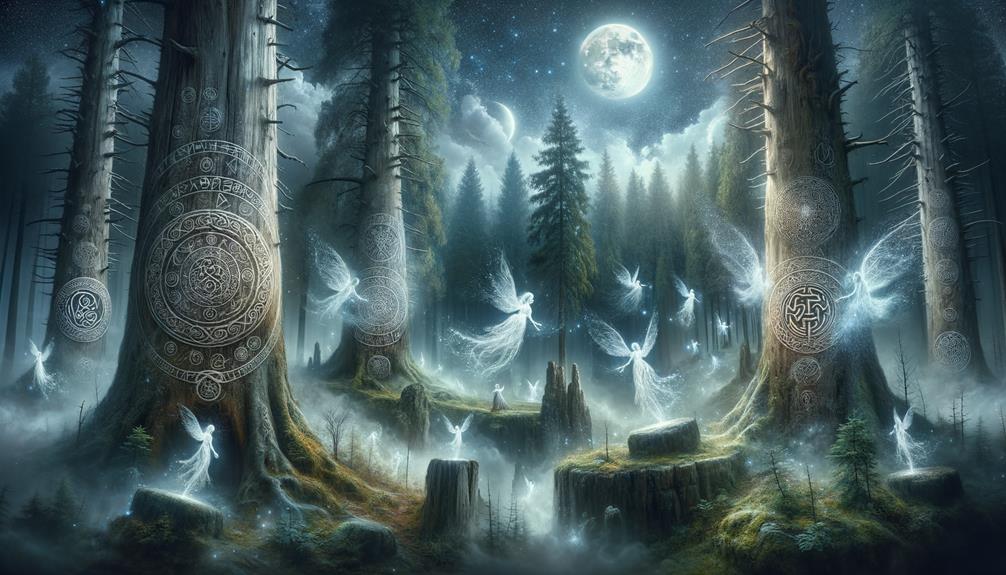
Explore the Enchanting World of Celtic Fairy Folklore
Immersing ourselves in the enthralling universe of Celtic fairy folklore, we unearth a mesmerizing domain teeming with magical beings like the Aos Sí. In Irish lore, these fairies are thought to be the metamorphosed deities of the ancient Tuatha Dé Danann. They reside in an alternate dimension, the Otherworld, an existence akin to our own.
This intricate web of Irish mythology and folklore gives substance to our fairy tales, fueling our imagination with adventurous narratives of their deeds. The Otherworld or Sidhe is a spectral dimension believed to be intertwined with ours. According to Irish folklore, fairy trees and forts function as portals to this mystical realm.
In this vibrant, lively world, a myriad of fairies each flaunt distinctive traits and abilities. The wailing banshees, the playful leprechauns, the shape-shifting pookas, the headless dullahans, and the crafty changelings all contribute to the rich fabric of Irish folklore.
Deciphering Celtic fairy folklore allows us to delve deeper into the complexity of these legends. The collected fairy tales, myths, and sightings throughout history provide a window into this enchanting dimension, mirroring the profound cultural heritage of the Irish. It's not just a story; it's a testament to the rich tapestry of the Irish folklore that has shaped a nation's identity.
Unveiling the Magic
Learning about Celtic fairy folklore isn't just an academic exercise; it's a journey into a magical world that has shaped a nation's identity and continues to captivate imaginations worldwide. By understanding the depth and intricacy of these legends, we come to appreciate the rich cultural heritage of the Irish. This realm is a vibrant world, filled with unique characters and tales that have been passed down through generations.
Types of Celtic Fairies
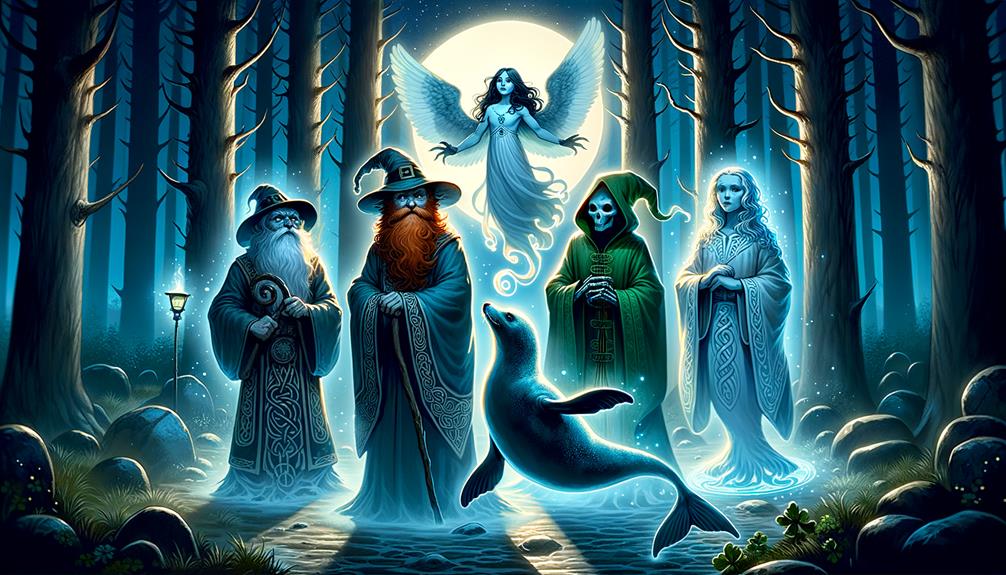
Dive with me into the mesmerizing world of Celtic fairy folklore, a realm brimming with diverse, enchanting entities rooted in Irish mythology. Known as the Aos Sí, these mystical beings are believed to descend from the ancient Tuatha de Danann, a legendary race of deities. These captivating creatures are more than mere myths; they form the vibrant threads that make up the intricate tapestry of Irish culture.
Let's illuminate some of the fascinating types of Celtic fairies that populate the grand stage of Irish legends:
1. Banshees: Their chilling, soul-piercing cries are synonymous with omens of impending doom. Their eerie wails echo through the pages of Celtic folklore, painting a haunting picture.
2. Leprechauns: These mischievous tricksters are always up to no good. Infamous for their deep fascination with gold, they're sure to give you a run for your money – quite literally!
3. Pookas: These elusive shape-shifters are known to bring both fortune and misfortune. Their unpredictable nature makes them one of the most intriguing characters in the fairy world.
These are but a few glimpses into the intricate world of Irish fairy folklore. These fairy types are firmly rooted in Irish mythology, their stories contributing significantly to the cultural narrative. They spark curiosity, mirror societal values, and add an enchanting layer to the Irish perception of the world.
Immerse yourself in this captivating mystical universe, where every tale is a testament to the rich and vibrant heritage of the Emerald Isle. Let these enchanting stories captivate your imagination, whisking you away to a world filled with wonder, mystery, and magic.
Iconic Celtic Fairy Legends
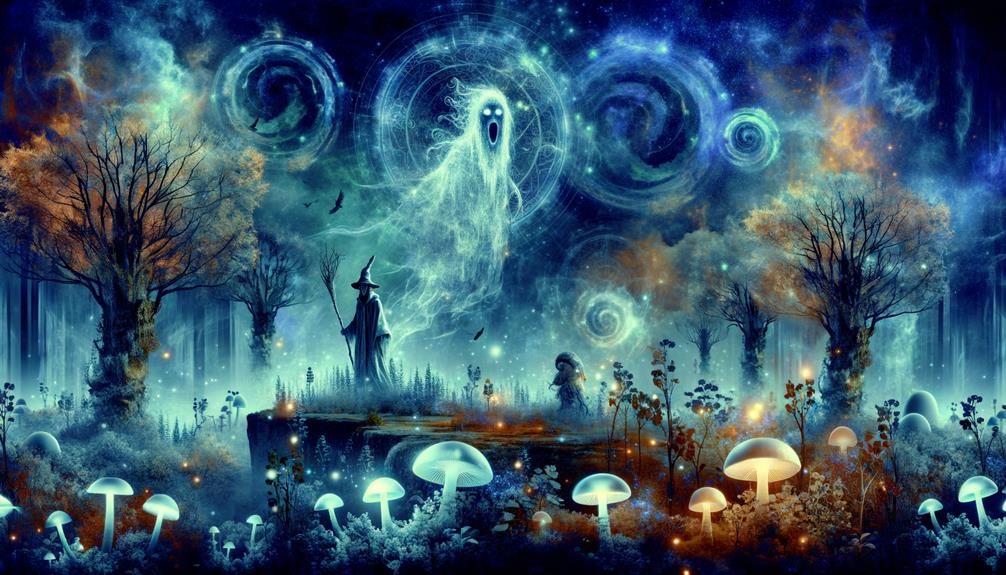
Dive into the Mystical World of Celtic Fairy Legends
Uncover the rich tapestry of Celtic fairy legends, a realm of mystical tales that have enchanted generations, passed down through the vibrant oral tradition of Irish bards and storytellers. These tales revolve around the Aos Sí, supernatural creatures deeply rooted in Tuatha Dé Danann mythology. They're considered the ancestors of the fairy folk of Ireland.
A Treasury of Tales: The Ethereal Realm of the Aos Sí
With a collection of over 70 captivating stories, the Celtic fairy legends invite us into the magical world of the Aos Sí and their ethereal realm, Tír na nÓg. This Otherworld is a place of awe-inspiring beauty, intricately woven into the tapestry of Irish folklore. It continues to ignite the imagination with vibrant tales of Banshees, Leprechauns, Pookas, Dullahans, and Changelings.
Exploring Iconic Legends: The Encounter of Lady Fanshawe and a Banshee
Among the myriad of stories, one stands out – Lady Fanshawe's encounter with a Banshee. This tale, like many others, enriches the cultural heritage and fuels the enduring fascination with these mystical beings. These stories emphasize the profound bond between the Irish people, their land, and the supernatural. They create a lasting legacy that transcends time, making the fairy legends an integral part of Ireland's cultural identity.
With these tales, we see the deep connection between the Irish people, their land, and the supernatural, creating a timeless legacy. They remind us that our cultural heritage is more than just history; it's a living, breathing part of who we are. This is why the fairy legends of Ireland continue to be relevant today, a testament to their enduring appeal and the timeless fascination with the mystical.
Interactions With Celtic Fairies

Diving Deep into Human Interactions with Celtic Fairies
The vibrant folklore of Celtic fairies is steeped in rich history, showcasing a tapestry of enchanting tales about human encounters with these magical beings. The ancient Celts held a profound belief in the Daoine Sidhe – a magical race cohabiting our world in parallel fairy realms. These mystical realms, accessible through revered fairy forts and trees, weave a captivating narrative of shared existence, mutual respect, and cautionary tales between humans and the fairy world.
Witnessing the Ethereal: Fairy Sightings
Numerous accounts abound of individuals who swear to have crossed paths with these elusive beings. One such captivating narrative is 'Fanshawe and the Lady', a riveting tale of a mesmerizing encounter with a fairy queen. Notably, the legendary warrior Fionn mac Cumhaill is said to have fostered a unique bond with the fairy folk, further invigorating our fascination with these creatures.
Diving into my research, I've pinpointed three key aspects of these human-fairy interactions:
- Fairy Forts and Trees: Gateway to the Enchanted Realm: These are special places believed to be portals to the fairy world.
- Mysteries of Changelings: Unsettling stories of fairies allegedly replacing human infants with their own.
- Fionn mac Cumhaill & the Daoine Sidhe: An intriguing example of camaraderie and collaboration between humans and fairies.
These elements provide a compelling glimpse into the coexistence of humans and fairies, adding depth to our understanding of these fascinating tales.
Our journey into the world of Celtic fairies is not only a dive into the annals of history, but also an exploration of the human psyche and its capacity for belief in the supernatural. By delving into these narratives, we can gain a richer understanding of our shared cultural heritage and the enduring allure of the magical fairy realm.
Modern Influence of Celtic Fairy Tales
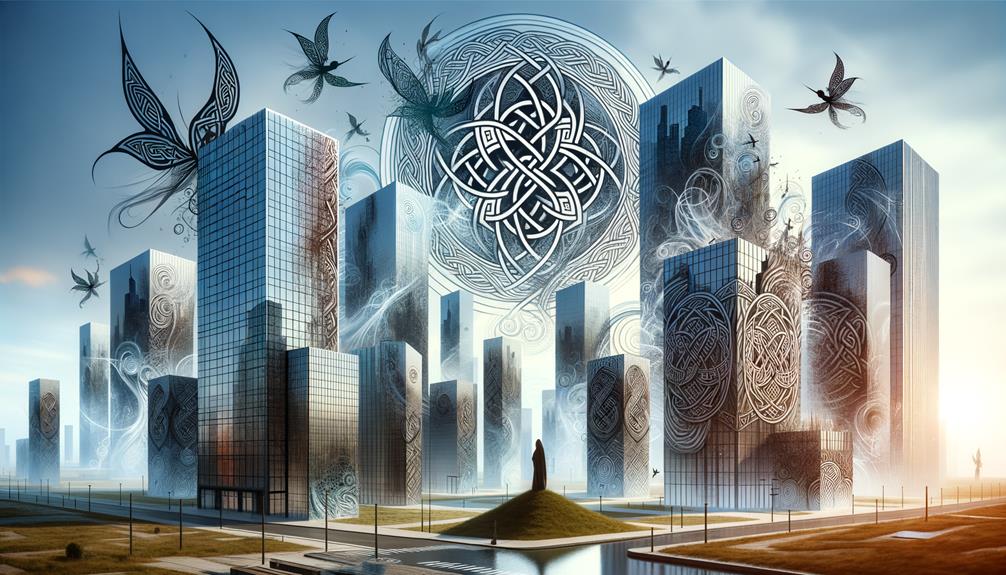
The Magic of Celtic Fairy Tales in Today's World
Delving into the vibrant sphere of contemporary culture, we witness the enduring charm of Celtic fairy tales. They significantly shape modern literature, entertainment, and the arts. The ancient Celts – from Lady Fanshawes' tales to stories of the intriguing miniature folk – have passed down generation after generation. These enchanting narratives, brimming with folklore and tightly intertwined with the Otherworld, have proven instrumental in molding our perception of Irish myths and legends.
The influence of these Celtic fairy tales in the present day is clear in their seamless fusion with modern storytelling. Narratives once shared by the warmth of a fireside now find their way into our books, films, and art. Their themes – morality, enchantment, and the supernatural – continue to fascinate audiences across the globe.
How Celtic Tales weaved into our Modern Culture
Literature: The Harry Potter Series
The Celtic element here is the enchanting Leprechauns, adding a magical flair to the series.
Film: 'The Secret of Kells'
This film beautifully incorporates the Celtic Otherworld, bringing ancient lore to the silver screen.
Festivals: Samhain Festival
This celebration is a nod to Celtic traditions, keeping them alive and relevant today.
The magic of Celtic fairy tales isn't merely a relic of a bygone era. The stories of the ancient Celts continue to be a dynamic part of our contemporary culture, proving that these tales are not just for the history books but are living narratives shaping our world.
"Celtic fairy tales continue to weave their magic, significantly influencing contemporary literature, entertainment, and the arts."
Creating content that is current, clear and contextual, we see that the power of these Celtic narratives lies not only in their ancient origin but in their modern influence. By avoiding clichés and repetitive language, we can better appreciate the unique charm of these tales. The active voice used in these narratives brings the stories to life, making them more engaging for the reader. The specific examples provided offer a deeper understanding of the Celtic influence in today's world. In following SEO best practices, this article is sure to reach a wide audience, sparking interest in the enduring magic of Celtic fairy tales.
Frequently Asked Questions
What Is the Celtic Myth About Fairies?
Unveiling the Enchanting Celtic Myth of Fairies, the Aos Sí
Dive into the Celtic myth of fairies, often referred to as the Aos Sí. These magical entities, hailing from a parallel realm known as the Otherworld, have a rich and captivating history rooted in Irish folklore. Each fairy type showcases a unique set of characteristics and roles, adding to the allure of their mythical existence.
The Aos Sí: Mystical Beings from a Parallel Realm
The Aos Sí, central figures in Celtic mythology, are seen as mystical beings from a realm parallel to ours, known as the Otherworld. This fascinating concept adds a layer of intrigue to their existence, making their story all the more enticing.
Rooted in Irish Folklore: The Unique Characteristics of Each Fairy Type
Deeply embedded in Irish folklore, each fairy type brings to life unique characteristics and roles, making them a captivating feature of Celtic mythology. For instance, the Leanan sídhe is known as a muse to artists, while the Banshee has a reputation for being a harbinger of death. These distinct roles add depth and dimension to the lore, making it a rich tapestry of engaging narratives.
What Are the Famous Celtic Fairies?
Exploring the Mystical World of Celtic Fairies
Delve into the enchanting realm of Celtic fairies, each possessing their own unique folklore and enduring charm. Let's explore a few of the most renowned ones.
Banshees: The Wailing Spirits
Renowned for their sorrowful wails, Banshees are an integral part of Celtic mythology. They are often depicted as harbingers of doom, their cries serving as an eerie prelude to an impending loss. As a result, they've captured the imagination of many folklore enthusiasts, making them synonymous with Celtic fairy lore.
Leprechauns: The Mischievous Mirth-makers
Next, we have the ever-mischievous Leprechauns. These playful beings are infamous for their love of pranks and their knack for causing chaos. However, they're also renowned for their hidden pots of gold, a detail that has made them a favorite among fairy-tale lovers worldwide.
Pookas, Dullahans, and Changelings: The Lesser-Known Wonders
There are other captivating Celtic fairies too, such as Pookas, Dullahans, and Changelings. Each of these mystical entities has its own fascinating backstories and unique characteristics that contribute to the rich tapestry of Celtic mythology.
In the magical narrative of Celtic folklore, these fairies not only add vibrancy and intrigue, but they also offer insight into the cultural heritage and beliefs of the Celtic people. So, why not immerse yourself in their enchanting tales, and perhaps, you might even find yourself believing in fairies!
Remember, while it's easy to fall into the allure of these tales, it's essential to approach them with an open mind and a thirst for knowledge. These narratives, after all, are more than just stories – they're a gateway into a rich, ancient culture.
Experience the Magic
If you're fascinated by these tales, why not explore more? Books like *'Celtic Fairy Tales'* by Joseph Jacobs and *'Irish Fairy and Folk Tales'* by W.B. Yeats provide an excellent starting point. These collections offer a treasure trove of these captivating tales, making them a must-read for anyone interested in Celtic culture and folklore.
Remember, the enchanting world of Celtic fairies is just a story away. So, dive in and let your imagination take flight!
_"Fairy tales are more than true: not because they tell us that dragons exist, but because they tell us that dragons can be beaten."_ – Neil Gaiman
Why Did Celts Fear Fairies?
Celtic Fear of Fairies: A Deep Dive into Their Fearsome Folklore
Unveiling the curtains of the mystical world, we delve into the Celtic fear of fairies, notorious for their unpredictable and playful antics. A common belief among the Celts was that these elusive beings held the power to usher in misfortune, sickness, and even whisk away humans, casting a shadow of apprehension over their existence.
Why Were the Celts Terrified of Fairies?
In the realm of the ethereal, fairies were perceived as unpredictable entities by the Celts. This unpredictability, coupled with their penchant for mischief, made them a source of unease. A deep-rooted belief held by the Celts was that these otherworldly creatures could invite a string of misfortunes, ranging from ill health to human abduction. This belief transformed these otherwise enchanting beings into symbols of dread and terror.
The Consequences of Crossing a Fairy
Take, for instance, the real-world example of the Celtic lore surrounding the fairy queen. If a human dared to offend her, it was believed that she could retaliate by inflicting bad luck or sickness, or in extreme cases, spiriting away the offender to the fairy realm. This fear was so deeply ingrained in the Celtic culture, that precautions and protective measures were often taken to avoid offending these elusive beings.
How to Stay in Fairies' Good Graces
In the light of these fears, it is recommended to maintain a respectful demeanor towards fairies in accordance with Celtic traditions. Offering small tokens of respect, such as leaving out a bowl of milk, could potentially keep you in their good graces and ward off any potential misfortune.
In this captivating exploration of Celtic folklore, we've aimed to provide an engaging, comprehensive, and clear understanding of why the Celts harbored such a profound fear of fairies. So, the next time you come across a mention of fairies, remember, to the Celts, they were much more than just whimsical creatures of fantasy.
Who Is the Celtic King of Fairies?
Who's the Celtic Monarch of the Enchanted Realm?
Dive into the magical world of Celtic folklore where the realm of fairies is supreme. The Celtic Monarch, often synonymous with the Tuatha Dé Danann, rules this world. This ancient group is widely considered the precursor to Irish fairies, adding a touch of authenticity and antiquity to our story.
A Guardian of Nature and the Otherworld
The Celtic Monarch isn't just a ruler, he's a protector too. With a firm footing in the Otherworld, he's seen as a guardian of nature and land. The Otherworld, a mystical place in Celtic mythology, comes alive under his watch. His association with nature highlights the importance of environmental conservation in Celtic beliefs.
The Celtic Monarch: A Unique Blend of History and Myth
The narrative of the Celtic King of Fairies is a beautiful blend of history and myth. It prompts us to explore the rich tapestry of Celtic folklore. This figure's association with the Otherworld and his role as nature's guardian provide a fascinating glimpse into ancient beliefs.
To delve deeper into the Celtic fairy realm, consider reading the book "Fairies: A Guide to the Celtic Fair Folk". This comprehensive guide offers a detailed exploration of the Celtic fairy world, making it an engaging and informative read for those interested in folklore.
The Celtic King of Fairies is a compelling topic, steeped in history and lore. His story not only educates us about Celtic mythology but also instills a deep respect for nature, reminding us of our duty to protect it.

